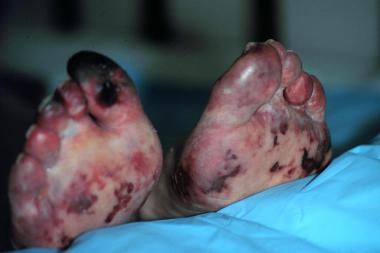As noted (see Overview, Etiology), patients at greatest risk for abdominal aortic aneurysms (AAAs) are those who are older than 65 years and have peripheral atherosclerotic vascular disease.
Accordingly, a history of smoking, chronic obstructive pulmonary disease (COPD), and hypertension is often elicited. Less frequent causes include Marfan and Ehlers-Danlos syndromes, collagen vascular diseases, and mycotic aneurysm. Patients who have a first-degree relative with AAA are at increased risk.
AAAs are usually asymptomatic until they expand or rupture. Patients may experience unimpressive back, flank, abdominal, or groin pain for some time before rupture. Isolated groin pain is a particularly insidious presentation. This occurs with retroperitoneal expansion and pressure on either the right or left femoral nerve. This symptom may be present without any other associated findings, and a high index of suspicion is necessary to make the diagnosis.
At times, AAAs may cause symptoms from local compression, including early satiety, nausea, vomiting, urinary symptoms, or venous thrombosis from venous compression. Back pain can be caused by erosion of the AAA into adjacent vertebrae. Other symptoms include abdominal pain, groin pain, embolic phenomena affecting the toes (eg, livedo reticularis, or blue toe syndrome; see the image below), and fever. Occasionally, small AAAs thrombose, producing acute claudication.

Atheroemboli from small abdominal aortic aneurysms produce livedo reticularis of feet (ie, blue toe syndrome).
Patients may describe a pulse in the abdomen and may actually feel a pulsatile mass.
It is important to note progressive symptoms, which should alert the clinician to the possibility of expansion with imminent rupture. An expanding AAA commonly causes sudden, severe, and constant low back, flank, abdominal, or groin pain.Syncope may be the chief complaint, with pain less prominent.
Symptoms of ruptured AAA
Persons with AAAs that have ruptured may present in many ways. The most typical manifestation of rupture is abdominal or back pain with a pulsatile abdominal mass. However, the symptoms may be vague, and the abdominal mass may be missed. Symptoms may include groin pain, syncope, paralysis, and flank mass. The diagnosis may be confused with renal calculus, diverticulitis, incarcerated hernia, or lumbar spine disease.
Transient hypotension should prompt consideration of rupture because this finding can progress to frank shock over a period of hours. Temporary loss of consciousness is also a potential symptom of rupture.
Patients with a ruptured AAA may present in frank shock, as evidenced by cyanosis, mottling, altered mental status, tachycardia, and hypotension. As many as 65% of patients with ruptured AAAs die of sudden cardiovascular collapse before arriving at a hospital.
AAAs may rupture into the vena cava, producing large arteriovenous fistulae. In this case, symptoms include tachycardia, congestive heart failure (CHF), leg swelling, abdominal thrill, machinery-type abdominal bruit, renal failure, and peripheral ischemia. Finally, an AAA may rupture into the fourth portion of the duodenum. These patients may present with a herald upper gastrointestinal bleed followed by an exsanguinating hemorrhage.
Source emedicine.com
Duc Tin Surgical Clinic
Tin tức liên quan

Performance diagnostique de l’interféron gamma dans l’identification de l’origine tuberculeuse des pleurésies exsudatives

A Mixed Phenotype of Airway Wall Thickening and Emphysema Is Associated with Dyspnea and Hospitalization for Chronic Obstructive Pulmonary Disease.

Radiological Approach to Asthma and COPD-The Role of Computed Tomography.

Significant annual cost savings found with UrgoStart in UK and Germany

Thrombolex announces 510(k) clearance of Bashir catheter systems for thromboembolic disorders
Phone: (028) 3981 2678
Mobile: 0903 839 878 - 0909 384 389







